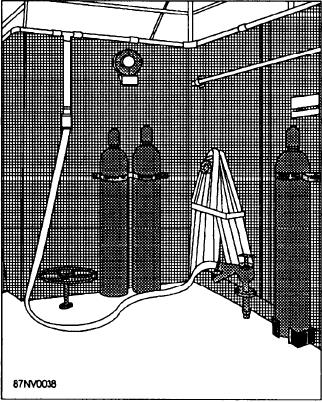
fireplug supplies the washdown nozzle array in its
aboard ship to provide a film of flowing water over all
immediate vicinity. A 1 l/2-inch fireplug can supply
of the exterior surfaces of the ship. This flowing film
an eight-nozzle array and a 2 l/2-inch fireplug can
of water prohibits chemical, biological, and
supply a maximum of 22 nozzles.
radiological (CBR) agents or particles from adhering to
the ship's exterior surfaces. For maximum
In addition to the installed sections of the interim
effectiveness, the water washdown system should be
water washdown system, portable manifolds with
activated before a CBR attack.
spaced nozzles are provided to cover areas where fixed
installations would be difficult to install or would
A permanent washdown system is now installed on
interfere with normal operations. When not in use, they
any ship under construction or when it enters a shipyard
should be stowed as near their point of use as possible.
for conversion. If a ship already in service does not
Figure 15-39 shows a portable manifold stowed while
have a washdown system, it will receive a kit to be
not in use.
installed by the ship's force as an interim measure. Both
types are supplied from the firemain.
In FY-84, the improved water washdown system
nozzles of LHSs and DD-963 class destroyers were
The interim water washdown system consists of a
replaced with NATO nozzles.
number of separate arrays (or pipe lines) connected to
topside fireplugs by short sections of firehose, as shown
Flushing System
in figure 15-38. Thus, the water washdown system,
instead of being a continuous topside piping system, is
The flushing system for commodes and urinals is
rather a series of small piping arrays with each array
supplied with seawater either by a branch from the
supplied by its individual fireplug.
firemain or by a separate sanitary and flushing pump
Each array consists of a series of plastic or
taking suction from the sea. When this system is
aluminum pipes connected together and secured to
supplied from the firemain, the branch is taken as near
topside structures. Each array is fitted with
the top portion of the main as possible so that sediment
appropriately spaced nozzles, and the array and nozzles
from the firemain will not enter the flushing system.
are arranged to ensure an effective coverage of weather
Since the firemain pressure is too high for a flushing
decks by the water washdown spray. In general, each
system, the water is led through a strainer to a reducing
valve, which reduces the pressure to 35 psi.
Air chambers are installed in the flushing system
where it runs to urinals and water closets. These air
chambers absorb water hammer caused by the quick
closing of the flush valves and spring-closing faucets.
If it were not for this provision, water hammer might
rupture pipes, break joints, and damage valves.
Drainage System
The drainage system aboard ship is divided into two
categories: the main and secondary systems, and the
plumbing and deck drains. Between them, these
systems collect and dispose of all the shipboard waste
fluids as authorized. The main drainage system consists
of piping installed low in the ship, with suction branches
to spaces to be drained and direct connections to
eductors or drainage pumps. This system generally
serves the main machinery spaces and a few other
spaces.
The secondary drainage systems supplement the
main drainage system wherever the main system cannot
be extended through spaces where piping is prohibited,
Figure 15-38.--Interim washdown system array connected to
or because the length of piping would be too great for
a topside fireplug.
15-45

